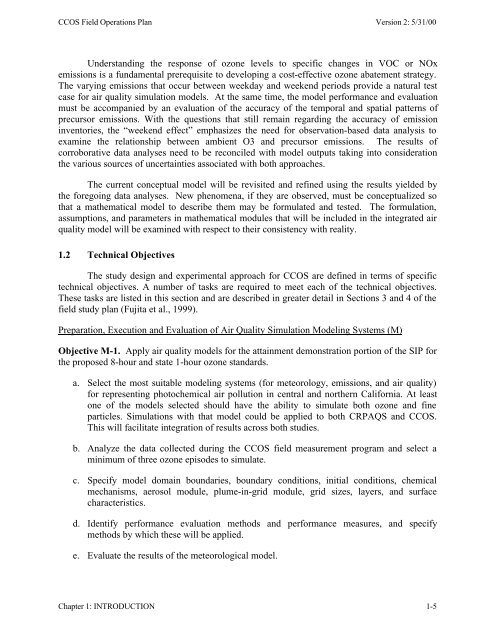Central California Ozone Study (CCOS) - Desert Research Institute
Central California Ozone Study (CCOS) - Desert Research Institute
Central California Ozone Study (CCOS) - Desert Research Institute
Create successful ePaper yourself
Turn your PDF publications into a flip-book with our unique Google optimized e-Paper software.
<strong>CCOS</strong> Field Operations Plan Version 2: 5/31/00<br />
Understanding the response of ozone levels to specific changes in VOC or NOx<br />
emissions is a fundamental prerequisite to developing a cost-effective ozone abatement strategy.<br />
The varying emissions that occur between weekday and weekend periods provide a natural test<br />
case for air quality simulation models. At the same time, the model performance and evaluation<br />
must be accompanied by an evaluation of the accuracy of the temporal and spatial patterns of<br />
precursor emissions. With the questions that still remain regarding the accuracy of emission<br />
inventories, the “weekend effect” emphasizes the need for observation-based data analysis to<br />
examine the relationship between ambient O3 and precursor emissions. The results of<br />
corroborative data analyses need to be reconciled with model outputs taking into consideration<br />
the various sources of uncertainties associated with both approaches.<br />
The current conceptual model will be revisited and refined using the results yielded by<br />
the foregoing data analyses. New phenomena, if they are observed, must be conceptualized so<br />
that a mathematical model to describe them may be formulated and tested. The formulation,<br />
assumptions, and parameters in mathematical modules that will be included in the integrated air<br />
quality model will be examined with respect to their consistency with reality.<br />
1.2 Technical Objectives<br />
The study design and experimental approach for <strong>CCOS</strong> are defined in terms of specific<br />
technical objectives. A number of tasks are required to meet each of the technical objectives.<br />
These tasks are listed in this section and are described in greater detail in Sections 3 and 4 of the<br />
field study plan (Fujita et al., 1999).<br />
Preparation, Execution and Evaluation of Air Quality Simulation Modeling Systems (M)<br />
Objective M-1. Apply air quality models for the attainment demonstration portion of the SIP for<br />
the proposed 8-hour and state 1-hour ozone standards.<br />
a. Select the most suitable modeling systems (for meteorology, emissions, and air quality)<br />
for representing photochemical air pollution in central and northern <strong>California</strong>. At least<br />
one of the models selected should have the ability to simulate both ozone and fine<br />
particles. Simulations with that model could be applied to both CRPAQS and <strong>CCOS</strong>.<br />
This will facilitate integration of results across both studies.<br />
b. Analyze the data collected during the <strong>CCOS</strong> field measurement program and select a<br />
minimum of three ozone episodes to simulate.<br />
c. Specify model domain boundaries, boundary conditions, initial conditions, chemical<br />
mechanisms, aerosol module, plume-in-grid module, grid sizes, layers, and surface<br />
characteristics.<br />
d. Identify performance evaluation methods and performance measures, and specify<br />
methods by which these will be applied.<br />
e. Evaluate the results of the meteorological model.<br />
Chapter 1: INTRODUCTION 1-5
















